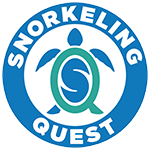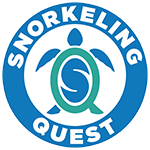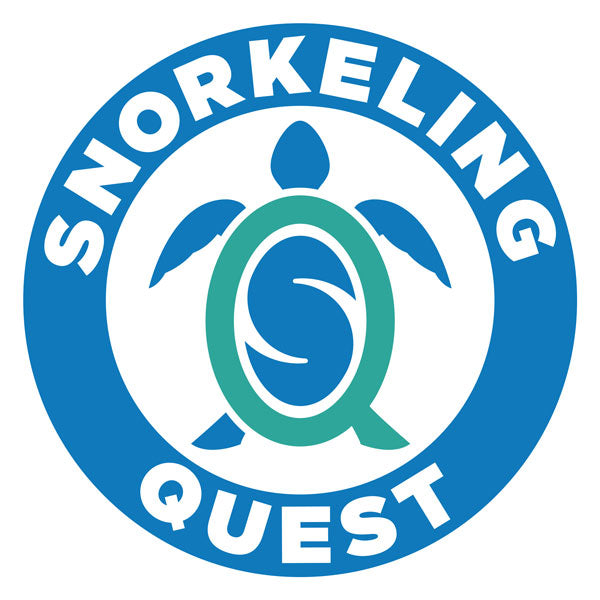Oahu Snorkeling Guide
Back to Top

Oahu offers many shore snorkeling opportunities around the island. From easy beach entrances with calm protected water, to free diving opportunities with underwater caves and arches, there are several options to choose from. This guide covers many snorkeling locations across the island.
The overall snorkeling on the island is pretty good if you know where to look. Some areas may be absent of healthy coral and others areas are teaming with life.
Check out our downloadable PDF snorkeling map set for Oahu that include extra detailed information about each location. Easy to use for quick offline reference.
Oahu is the most popular of the Hawaiian Islands for...
Read More +
...tourist visits. Certain areas are known to be busier than others. The north shore can get busy on weekends and during the height of the tourist season. Parking on the north shore can be an issue, so try to arrive earlier in the day. To fully enjoy the best snorkeling on the island you will need to rent a car. While there are public transportation options, they are more suited for in town transportation than across the island. From Honolulu to the north shore is about a 1 hour drive. The best time of year to snorkel Oahu is in the summer months when the water is the warmest and the wind is the calmest. The warmest ocean temp is in September and the coldest ocean temp is in March. Being the most popular tourist destination and the most populated of the Hawaiian Islands, there is a big fishing pressure on Oahu. Along with fishing, spear fishing is allowed and you will see folks out chasing fish in some snorkeling areas. The larger fish may unfortunately be picked off especially close to shore. There are a few marine preserve areas on Oahu and you may notice the difference in fish behavior.
Unlike other snorkeling guides, here at Snorkeling Quest we personally snorkel and video each location we list in our guides. We do the hard work so you don’t have to. Our goal is to save you time on your vacation and bring you directly to the snorkeling spot. Please enjoy this snorkeling guide and check out our downloadable pdf maps of Oahu for even more detailed information.
Oahu Snorkeling Map
(Click the box on the map header to open in Google Maps app)
Click to jump to each location:
Alan Davis Cove
Take a short hike to a nice little snorkeling bay. The snorkeling area itself is a limited area, but it has great water clarity and a fair amount of fish and coral. The bay itself is calm, but the surrounding seas crash dramatically on the surrounding shoreline. Consider ditching the fins and just use water shoes or sandals. Take your time and explore around the small bay. Peak amongst the rocks on the east side. The best entry seems to be from the rocks on the east side of the bay. The back of the bay is too shallow to enter. The hike down to Alan Davis Beach is .5 miles. Park at Kaiwi State Scenic Shoreline.
Electric Plant
Public beach across from the power plant. Popular area for local snorkelers and shore divers. The main attraction is two large discharge pipes 700 ft offshore. These pipes are approximately ten feet in diameter and discharge a tremendous amount of warm water. The pipes sit in 20 ft of water and coral grows on the structures and fish are attracted to the area. The surrounding area is sandy and dotted with coral areas in about 20 ft of water with good visibility. Spinner dolphins are occasionally seen in the early morning. Overall, a good snorkeling location. There is also good underwater structure to the north in front of the electric plant. There is a little buddha statue in about 10 feet of water. Farther out is an undercut rock with a “cave” area in about 20 ft of water. Snorkel tour boats can sometimes be seen in this area.
Hanauma Bay
Very popular beach and snorkeling destination on Oahu. The bay was a volcano crater that opened on one side to the ocean. The bay has some of the best snorkeling on the island. There is a strict reservation system to enter for the day. All visitors are required to watch an introduction video. It will describe the areas to snorkel. The reef by shore is a barrier to the larger bay. In 2 locations marked by buoys, there are openings in the reef to the larger bay. The introduction video says to not go past the buoys, but then says to ask the lifeguards for questions. The lifeguards will tell you it is alright to go past the buoys to the larger bay.
The inside reef is more suited for beginner snorkelers. The water has lower visibility and limited coral, but fish are used to humans and will let you approach them.
The larger bay beyond the inside reef is spectacular. You will need intermediate or advanced snorkeling skills to come out here. The coral health improves dramatically as you go further to the bay and visibility will improve to 40ft+. Towards the east side of the opening to the bay is an extensive coral reef in about 20 to 30 ft of water. Coming out here will possibly expose you to larger waves. Make sure you have the skills to swim here and back. Passing through either of the 2 entrances to the larger bay does get shallow, you may need to time your entrance and exit with the waves to avoid scraping your belly on the reef.
He’eia State Park (Kane’ohe Bay)
A small State Park giving access to the larger Kane’ohe Bay. Hawaii State Parks considers this the healthiest reef in the state. Shallow “blob” areas of the bay are known as patch reefs. The edges of the patch reefs are the best areas to snorkel. Here you can find healthy coral with good diversity of fish. The top of the patch reefs are shallow at around 2 feet deep. Turtles are a common site napping amongst the coral. The reef stays mostly near the surface and fades after about 15 feet deep. Visibility plummets as you go deeper.
The patch reefs are a fair distance from shore and take some effort to reach. They only public access is from He’eia State Park. They rent kayaks, but you will need to have a way to secure the kayak in open water while you snorkel. You can also reach the reef by swimming out from the kayak launch area. Swim towards the marina, then follow the edge of the patch reef out. This is an active boat channel, but if you hug the reef edge the boats won’t come near.
Keawa’ula Beach
Beaches and bay with calmer waves and good underwater visibility. The main feature is a section of large smooth rocks with gaps in between. Undercut ledges provide shelter for fish. Coral lines the edges. This area sits in about 20 ft of water.
Ko Olina Lagoons
Manmade lagoons across four resorts offering basic snorkeling. Nice easy snorkeling protected from waves. Coral is limited, but a decent variety of fish can be seen. A paved walkway connects the lagoons amongst well-manicured resort properties. The public is welcome.
Lagoon 1, Kohola is the largest and deepest. Lagoon 2 Honu and Lagoon 3 Nai’a are about the same size and depth, but smaller than Lagoon 1. Lagoon 4 Ulua is the smallest and shallowest.
Snorkel along the rocks on the ocean side of the lagoons. The roped off area is a warning of rip current. It is present, but not strong.
As a bonus, a small natural cove and beach to the north of Lagoon1 may have monk seals present. There is a small walkway and gate to access from the resort.
Public parking is available next to the resorts. The lots are not well marked by design, but the public is welcome. Facilities are available at Lagoon 1 and 3. Consider parking in one area and walking between the lagoons.
Kuilima Cove (Turtle Bay Resort)
Nice easy beginner snorkeling area. Small shallow bay in a resort offers calm seas to snorkel. Shallow rocks at the entrance of the bay prevent waves from entering. There is limited coral and depths are less than 5 feet. However, there is a good diversity of fish. Good place for micro photography. This snorkel area is inside Turtle Bay Resort, the general public is welcome.
Lanikai Beach
Public beach with a vast labyrinth of coral clusters covering a large area. The coral starts immediately off the beach and sits in about 10 feet of water. Overall, the coral is not very healthy and visibility is low. The benefit is having a coral reef directly off a sandy beach. A barrier reef farther offshore protects this area from large waves making it a good beginner snorkeling area Parking at this beach is challenging. There is no public lot and limited street parking is the only option. You may have to circle around to find a parking spot and walk a fair distance. The beach does stretch a fair distance and has access lanes near every cross road.
Makaha Beach
Public beach with easy access. A shallow coral flat area slowly descends to canyons, ledges and cave areas farther out. Those areas are in 20ft to 40ft of water and go deeper. Dive and pleasure boats are known to frequent this area, about 1,500ft from shore. This area is to the northwest (right) side of the bay. Beginner snorkelers will enjoy the coral flat area and free divers will enjoy the ledges and caves farther out. Please be safe and don’t try anything beyond your skill level.
Maunalua Bay Turtle Tour
Take a boat tour to see turtles in Maunalua Bay. The turtles are in about 20 feet of water and occasionally surface. This is a “cleaning station” for the turtles. They lie still and small fish pick algae and parasites off them. If you have free diving skills you can easily reach them near the bottom. The bay can get rough with waves. The tour company should have a floating platform you can hang onto with a sea scooter type propulsion system. There should be several tour companies that offer this turtle tour. Do an internet search for “Maunalua Bay Turtle Tour”.
Pokai Breaker
Manmade breaker wall with large boulders at a public park. Inside the breaker is calm water, great for beginners. While outside the breaker, waves can get rough. Limited coral, but plenty of fish with adequate visibility. Depths less than 20ft. Turtles can be seen munching on the grass that grows on the rocks. Outside the breaker seemed to have the most turtles. The breaker is frequented by fishermen. You might need to swim under a fishing line.
Queens Walkway
Basic snorkeling in a limited area, but is one of the few places to snorkel along Waikiki. A short walkway pier goes a short distance into the water. This gives some protection from the waves. There is limited coral farther out near where the waves break. Some fish can be seen and visibility is limited. Depths are around 5 ft.
Sharks Cove
Shallow tide pools and protected cove for beginner snorkeling, but this area also offers wonderful free diving entertainment. There are numerous caves and arches allowing swim throughs in 20 to 30 feet of water. Out of the cove and to the right (North) seems to be the highest concentration. Many of these caves are hard to spot from the surface. They will be hiding in shadows along wall and ledges. Be safe out there and do not attempt something beyond your skill level.
There is camping available right on the beach through the State of Hawaii. Basic camping with limited facilities. Don’t forget about visiting the far east side of the bay where turtles are commonly seen. See Kiholo Bay Turtles.
Three Tables
Nice beginner snorkeling area off a small beach. The area is named for 3 flat rock formations directly offshore. The rocks provide some protection from the waves making this ideal for beginner snorkelers. Coral is limited, but good variety of fish to see. There is a small underwater canyon feature to the north and east of the 3 tables.
Waimea Bay
Large beautiful beach on the North Shore. The best snorkeling is along the south west side of the beach, amongst the rocks. Large boulders and rocks are scattered over a sand bottom. There is limited coral and fish to view, but the beautiful beach and good underwater visibility make it worthwhile.
Hey, check this out:
For even more detailed information on these snorkeling sites, download our Oahu snorkeling maps. Full color maps in .pdf version. Extra notes, tips and tricks to maximize your experience. Download for offline use and take with you to the snorkel spot.



